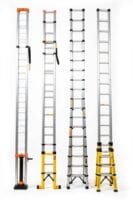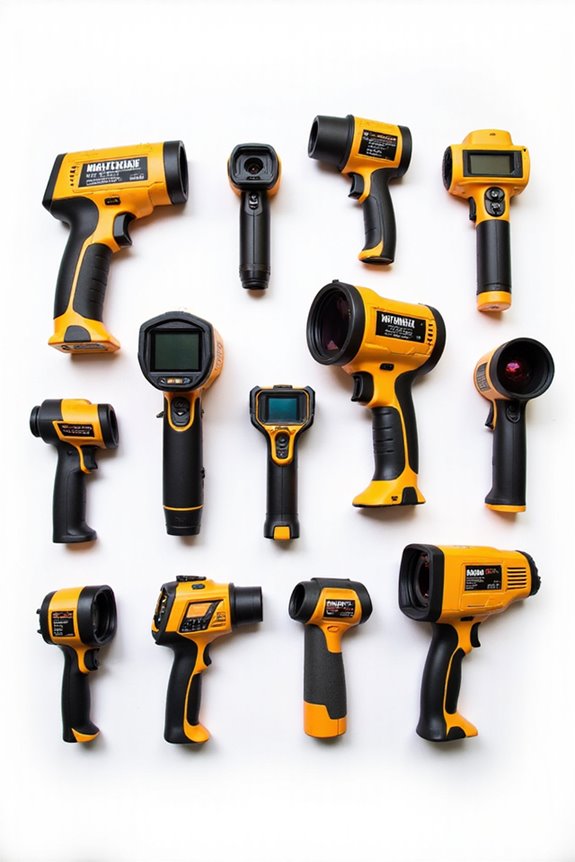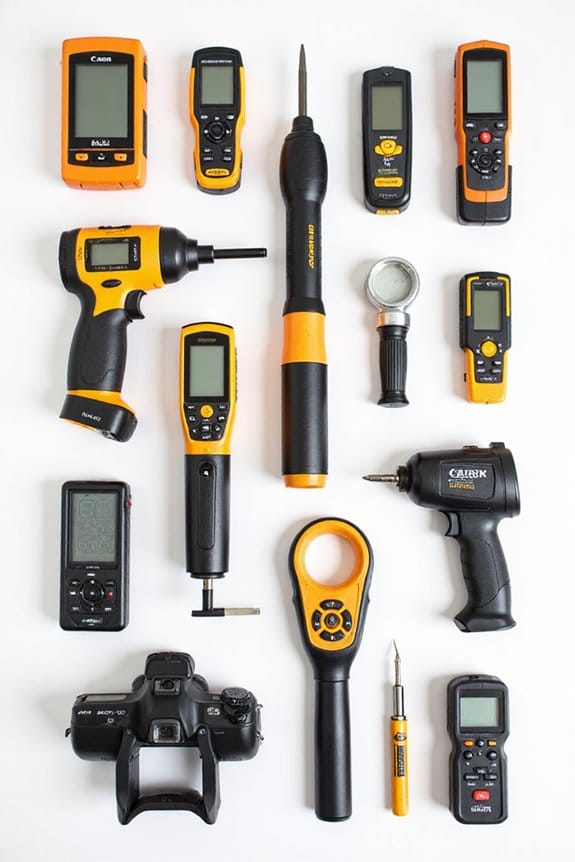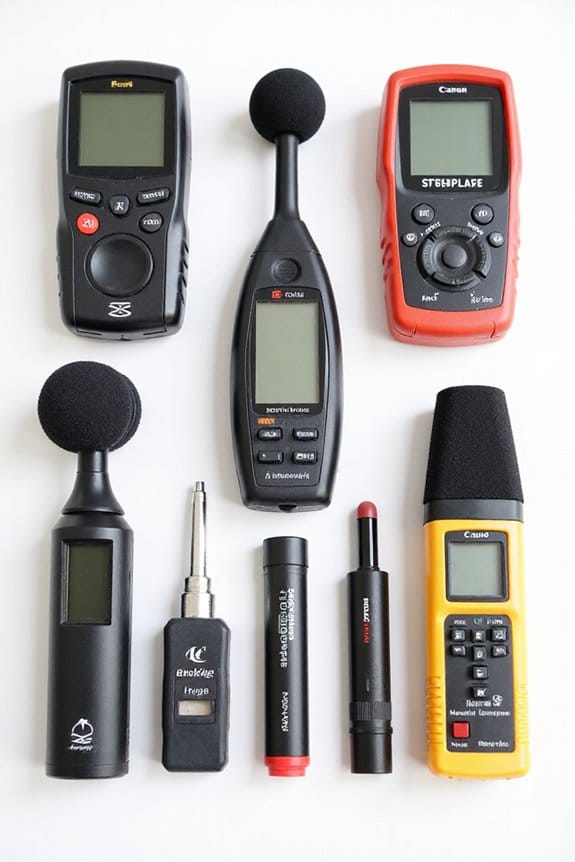As an Amazon Associate, we earn from qualifying purchases. Some links may be affiliate links at no extra cost to you. Although our opinions are based on curated research, we haven't used these products. Articles generated with AI.

10 Best Milwaukee Voltage Testers for Precise Electrical Work (Reviewed & Rated)
Looking for the best Milwaukee voltage testers for your electrical work? You’re in luck! Here are five top picks: 1) Milwaukee Non-Contact Voltage Detector with Infrared Thermometer for smart detection. 2) KAIWEETS Voltage Tester, a great option for dual voltage detection. 3) Milwaukee 2202-20P, known for its accuracy and long tip design. 4) Klein Tools NCVT1P, a portable tester pen. 5) MILWAUKEE Voltage Detector With LED for compact convenience. Stick around to see detailed reviews and more!
Key Takeaways
- Milwaukee offers a range of voltage testers featuring non-contact detection, ideal for residential and industrial electrical work.
- Each Milwaukee tester is designed with high accuracy, ensuring reliable voltage readings across various applications.
- Features such as built-in LED flashlights and audible alerts enhance usability in low-light or noisy environments.
- Durable construction ensures Milwaukee voltage testers withstand tough working conditions, providing long-term reliability.
- Advanced models include dual-functionality, combining voltage detection with infrared temperature sensing for comprehensive electrical assessments.
For Milwaukee Non-Contact Voltage Detector With Infrared Thermometer
If you’re someone who often finds themselves fiddling with electrical systems—be it at home, in a commercial setting, or even on larger industrial jobs—the Milwaukee Non-Contact Voltage Detector with Infrared Thermometer is a must-have tool. Here’s why:
- Smart Detection: This device allows you to find live wires without touching them. Talk about peace of mind!
- Infrared Tech: It accurately measures temperatures, helping identify potential problems before they escalate.
- User-Friendly: Its design is made for easy handling in any environment, so you can focus on the task at hand.
In short, it’s practical, reliable, and a bit of a superhero in your toolbox!
Best For: Individuals working with electrical systems in residential, commercial, or industrial settings who need a reliable tool for safe voltage detection and temperature measurements.
Pros:
- Non-contact voltage detection enhances safety by allowing users to locate live wires without direct contact.
- Advanced infrared technology provides accurate temperature measurements, enabling early identification of potential electrical issues.
- User-friendly design ensures easy handling, making it suitable for various environments.
Cons:
- May require batteries for operation, which can mean additional costs over time.
- Limited to detecting voltage within a specific range, which may not accommodate all electrical systems.
- Users may need to become familiar with the device’s features before fully utilizing its capabilities.
KAIWEETS Voltage Tester/Non-Contact Voltage Tester
Sale
KAIWEETS Voltage Tester/Non-Contact Voltage Tester with Signal Percentage, Dual Range AC...
- SAFETY FIRST: It will send out multiple alarms through sound and light. When the voltage is detected, the tip will send out red light and beep. When the higher the sensed...
- NON-CONTACT: With NCV inductive probe for AC voltage; Just place the tip near a terminal strip, outlet, or supply cord. When the tip glows red and the pen beeps, you know...
- DUAL RANGE: Detects standard and low voltage (12-1000V AC / 70-1000V AC) for more sensitive and flexible measurements. Press the S button to adjust sensitivity and adapt...
The KAIWEETS Voltage Tester/Non-Contact Voltage Tester is a fantastic choice for anyone concerned about electrical safety, whether you’re a seasoned electrician or a DIY enthusiast.
- Dual Voltage Detection: It detects AC voltage from 12V-1000V. Just put the tip near terminals or cords!
- Smart Safety Features: Enjoy alarms for both high and low voltage, plus a high voltage alert for extra caution.
- User-Friendly Design: Its bright LED flashlight helps in poorly lit areas, and it’s pocket-sized for easy transport.
Best For: Individuals seeking a reliable and safe tool for voltage detection in electrical work, including electricians and DIY enthusiasts.
Pros:
- Dual voltage detection allows for quick and accurate voltage identification from 12V to 1000V.
- Smart safety features include multiple alarms and high voltage alerts for enhanced safety during use.
- Compact and portable design with a built-in LED flashlight makes it convenient for use in various environments.
Cons:
- Some users find the beeping alarm excessively loud, with no volume control option available.
- There may be compatibility issues with rechargeable batteries, with a preference for alkaline batteries reported by some users.
- Caution is advised as reliance on this device alone for voltage detection may have limitations.
Milwaukee 2202-20P Voltage Detector with LED 2-Pack
No products found.
Looking for a reliable voltage detector that won’t let you down? The Milwaukee 2202-20P Voltage Detector with LED 2-Pack is a solid choice. Here’s why:
- Performance: Users rave about its accuracy, often deeming it the best around.
- Design: The long tip fits most outlets, and it’s got an LED flashlight—handy, right?
- Battery Life: This detector lasts a long time before needing replacements. Just be careful; some users wish it had better durability.
- Professional Use: Ideal for electricians, it’s perfect for checking power in tough settings.
Best For: Electricians and DIY enthusiasts looking for a reliable and efficient voltage detection tool.
Pros:
- Excellent performance with high accuracy, often rated the best among competitors.
- Convenient design with a long tip that fits most outlets and includes an LED flashlight.
- Impressive battery life, allowing for prolonged usage before needing replacements.
Cons:
- Some users express concerns about the product’s durability and potential for damage if dropped.
- Non-contact readings may occasionally result in false positives.
- Reports of misrepresentation by sellers regarding product features, particularly the LED functionality.
Klein Tools NCVT1P Voltage Tester Pen (50V to 1000V AC)
Klein Tools NCVT1P Voltage Tester, Non-Contact Low Voltage Tester Pen, 50V to 1000V AC, Audible and...
- NON-CONTACT DETECTION of AC voltage in cables, cords, circuit breakers, lighting fixtures, switches, non-tamper-resistant outlets, and wires
- CLEAR INDICATION: Bright LED illuminates green to indicate tester is operational and flashes red and emits a beeping alert when voltage is detected
- BROAD APPLICATION with a 50 to 1000V AC power detection range
For anyone tackling electrical work—whether you’re a DIY enthusiast or a seasoned professional—the Klein Tools NCVT1P Voltage Tester Pen is a reliable companion. This non-contact tester detects AC voltage from 50V to 1000V, perfect for checking cables, circuit breakers, and lighting fixtures.
- User-Friendly: It’s lightweight, features a pocket clip, and boasts drop protection for durability.
- Voltage Alerts: A bright LED shows green when operational and red with an audible alert for detected voltage.
- Smart Design: The auto power-off keeps your batteries alive longer.
It’s not Fluke precise, but it gets the job done without breaking the bank!
Best For: The Klein Tools NCVT1P Voltage Tester Pen is best for DIY enthusiasts and professionals needing a reliable and budget-friendly tool for detecting AC voltage.
Pros:
- Lightweight and portable design with a pocket clip for easy carrying.
- Bright LED indicators for operational status and voltage detection alerts.
- Auto power-off feature extends battery life, making it convenient for frequent use.
Cons:
- Sensitivity may not be as high as competitor models like Fluke.
- Not ideal for tamper-resistant outlets without using alternative models.
- Limited to AC voltage detection, not suitable for DC applications.
MILWAUKEE Voltage Detector With LED
MILWAUKEE Voltage Detector With LED
- Milwaukee
- Battery Powered
- Green and red
When tackling electrical projects, having a reliable voltage detector is essential, and the Milwaukee Voltage Detector With LED stands out, especially for DIY enthusiasts and professionals alike. Here’s why you’ll love it:
- User-Friendly Design: Its compact size, only 9 x 2 x 1 inches, makes it easy to carry in your pocket.
- Visual and Audio Alerts: A green light means power’s on, while a loud beeper and blinking red light warn of voltage.
- Versatile Range: It detects voltages from 50 to 1,000 AC—great for a variety of tasks.
- Durability Concerns: Some users reported minor durability issues, so handle it with care.
Just remember, it requires 2 AAA batteries (not included), so grab those!
Best For: DIY enthusiasts and professionals who need a reliable and user-friendly voltage detector for electrical projects.
Pros:
- Compact and portable design fits easily in your pocket.
- Visual and audio alerts provide clear indications of voltage presence.
- Wide voltage detection range of 50 to 1000 AC makes it suitable for various tasks.
Cons:
- Some users have reported minor durability issues, such as hairline cracks.
- Batteries are not included, requiring an additional purchase of 2 AAA batteries.
- There may be concerns about battery life during extended use.
Milwaukee 2235-20 400 Amp Clamp Meter
Sale
Milwaukee 2235-20 400 Amp Clamp Meter
- The product is easy to use
- The product is durable
- The product is manufactured in Taiwan
The Milwaukee 2235-20 400 Amp Clamp Meter is perfect for electricians and DIY enthusiasts who demand both accuracy and ease of use. Here’s why it stands out:
- Versatile Measuring: With a voltage range of 600V AC/DC and an impressive 400 amps capacity, you’ll tackle most electrical jobs.
- User-Friendly Design: It features a clear display, even in low light, and a thin jaw for tight spaces. The built-in LED work light? A game changer!
- Durability: Rugged construction means it withstands tough conditions, making it reliable over the years.
Don’t underestimate the value—this meter’s quality makes it a solid investment!
Best For: Professional electricians and DIY enthusiasts looking for a reliable and easy-to-use clamp meter for various electrical tasks.
Pros:
- Clear, readable display and built-in LED work light enhance usability in low light conditions.
- Durable construction capable of withstanding tough working environments.
- High accuracy and reliability, with many users reporting satisfaction over long-term use.
Cons:
- Some users have reported receiving second-hand products instead of new ones.
- Concerns about the durability of specific components, such as the amp clamp wire.
- Varied customer service experiences, with some users seeking refunds for unsatisfactory purchases.
Klein Tools NCVT3P Dual Range Non Contact Voltage Tester
Sale
Klein Tools NCVT3P Dual Range Non Contact Voltage Tester, 12-1000V AC Pen, Flashlight, Audible and...
- VERSATILE VOLTAGE DETECTION: This Voltage Tester offers non-contact detection of low voltage in security, entertainment, communications, environmental control, and...
- CLEAR INDICATION: Bright LED illuminates green to indicate tester is operational and flashes red and emits a beeping alert when voltage is detected
- BRIGHT FLASHLIGHT: Equipped with a bright flashlight, this tester illuminates the work area, allowing for enhanced visibility. The flashlight can also be used...
Looking for a reliable tool to detect voltage without breaking a sweat? The Klein Tools NCVT3P Dual Range Non-Contact Voltage Tester could be just what you need. Here’s why you’ll love it:
- Voltage Range: Detects 12-1000V AC, perfect for various projects.
- Safety First: Non-contact design reduces shock risk; CAT IV 1000V rated.
- User-Friendly: Lightweight, pocket-sized, and has a handy flashlight.
- Indicators: You’ll get visual and audible alerts—green for no voltage and red for live wires.
- Power Management: Auto power-off saves battery life, but keep an eye on that low-battery indicator!
It’s a must-have for electricians and DIYers alike!
Best For: Electricians, DIY enthusiasts, and anyone working with electrical systems looking for a reliable and safe voltage detection tool.
Pros:
- Lightweight and compact design with pocket clip for easy portability.
- Dual range detection (12-100V AC and 100-1000V AC) for versatility in various projects.
- Visual and audible indicators provide clear feedback on voltage presence, enhancing user safety.
Cons:
- Some users report sensitivity issues, occasionally leading to false positives on open circuits.
- Requires two AAA batteries, with reports of high battery consumption during frequent use.
- Higher price point compared to basic voltage testers may deter budget-conscious buyers.
Fluke 1AC II VoltAlert Non-Contact Voltage Tester
Sale
Fluke 1AC II VoltAlert Non-Contact Voltage Tester, Pocket-Sized, 90-1000V AC, Audible Beeper, CAT IV...
- Be aware of voltage easily - the tip glows red and a beeper sounds when voltage is detected
- Continuous self-test so you always know it’s working
- Voltage detection range for wide application use - 90 V to 1000 V AC or 200 V to 1000 V AC
For anyone working in electrical fields—whether you’re a seasoned electrician or a DIY enthusiast—the Fluke 1AC II VoltAlert Non-Contact Voltage Tester stands out as a reliable companion. Here’s why it’s a must-have:
- Versatile Detection: With a range of 90-1000V AC, it’s perfect for various electrical tasks.
- User-Friendly Alerts: The glowing red tip and beeper alert you to live wires—great for safety!
- Compact Design: It’s pocket-sized, making it super convenient to carry around.
- Robust Reliability: Many users trust its consistent performance over other brands.
You’ll appreciate its two-year warranty too—always a plus!
Best For: The Fluke 1AC II VoltAlert Non-Contact Voltage Tester is best for electricians, maintenance professionals, and DIY enthusiasts who need a reliable tool for detecting live wires safely.
Pros:
- Easy-to-use design with audible and visual alerts for detecting voltage.
- Compact and portable, making it convenient to carry in a pocket.
- Trusted for its consistent reliability and performance, preferred over competitors.
Cons:
- Some users have reported issues with the durability of the clips after extended use.
- The design may not accommodate users looking for a replaceable housing option.
- Limited to AC voltage detection, which may not meet all electrical testing needs.
Klein Tools Outlet Tester Kit (80025)
Sale
Klein Tools 80025 Outlet Tester Kit with GFCI Tester and Non-Contact Voltage Test Pen, 2-Piece
- SMART BUY: A complete, high-performance kit that offers convenience and value
- COMPLETE OUTLET TESTER TOOL KIT: Includes GFCI Tester (Cat. No. RT210) and Non-Contact Voltage Tester Pen (Cat. No. NCVT1P)
- DETECT COMMON WIRING PROBLEMS: Quickly identifies wiring issues in standard and GFCI receptacles
Ready to tackle some electrical issues around the house? The Klein Tools Outlet Tester Kit (80025) is your go-to companion! Here’s what you need to know:
- Two Essential Tools: This kit includes a GFCI Tester and a Non-Contact Voltage Tester. Perfect for spotting wiring problems!
- Easy to Read: Bright LED indicators give you instant feedback—green means go, red means uh-oh!
- User-Friendly: The digitally controlled power button makes operation a breeze.
With over 160 years of Klein quality behind it, you can trust this kit to be reliable. It’s a smart investment for any DIY enthusiast or homeowner. Happy testing!
Best For: This product is best for homeowners and maintenance workers looking for reliable and easy-to-use electrical testing tools.
Pros:
- Bright LED indicators provide clear, instant feedback on electrical status.
- Includes both GFCI and Non-Contact Voltage Testers for versatile usage.
- User-friendly design features a digitally controlled power button for ease of operation.
Cons:
- May not include advanced features found in higher-end testers.
- Limited to basic electrical testing; specialized tasks may require additional tools.
- Some users may find it less durable if used in demanding commercial environments.
Heavy Duty 3-72V Digital LED Automotive Test Light
Heavy Duty 3-72V Digital LED Automotive Test Light, Circuit Tester with Polarity Indicate and...
- 【3-72V WIDER TESTING RANGE】 JASTIND premium automotive test light is upgraded to 3-72V voltage testing range, wider than most test lights on the market. This auto...
- 【LED DIGITAL DISPLAY & AUXILIARY LIGHTING】 Heavy Duty auto circuit light tester with LED digital display, voltage reading resolution to .1V with high accuracy to...
- 【BIDIRECTIONAL VOLTAGE TESTING & COMPUTER SAFE】 This is a bidirectional voltage tester with 2 color LED lights and a buzzer for volt polarity indicating, attach the...
The Heavy Duty 3-72V Digital LED Automotive Test Light is a game-changer for anyone tinkering with automotive electrical circuits. It offers a testing range of 3-72V, perfect for checking headlights, taillights, and batteries.
- Digital Display: The LED screen shows voltage readings with a resolution of .1V—pretty impressive, right?
- Polarity Indicator: You’ll love the dual-color lights: red for positive and green for negative.
- User-Friendly Design: The sharp stainless steel probe makes accessing tight spots a breeze.
With a commitment to quality and solid customer support, this tool might just become your new favorite!
Best For: DIY automotive enthusiasts and professionals looking for a reliable tool to test electrical circuits in vehicles.
Pros:
- Precise Readings: The LED digital display provides accurate voltage readings with a resolution of .1V.
- User-Friendly Features: The dual-color LED lights and buzzer simplify polarity indication for quick troubleshooting.
- Durable Design: Features a sharp stainless steel probe and extended flexible wire for easy access and convenience.
Cons:
- Audible Feedback: Some users have noted a desire for a louder audio tone for the buzzer.
- Limited Voltage Range: Testing capabilities are confined to a range of 3-72V, which may not cover all applications.
- Potential Learning Curve: New users may need time to familiarize themselves with the dual-color LED system and digital display.
Factors to Consider When Choosing a Milwaukee Voltage Tester

When you’re picking a Milwaukee voltage tester, there are a few key factors to keep in mind. First, consider the voltage detection range—it’s vital for your specific tasks. Also, safety ratings and usability will guarantee you get the job done without a hitch, so let’s break down what you need to know.
Voltage Detection Range
Choosing the right Milwaukee voltage tester really starts with understanding its voltage detection range. Here’s what you should consider:
- Common Ranges: Most models detect from 50V to 1000V AC. Make certain your tester covers your usual needs.
- Professional Use: If you’re working in commercial or industrial settings, look for testers with higher ranges like 600V or 1000V.
- Dual-Range Detection: Some testers can identify both low and high voltages. This versatility can save you from grabbing multiple tools.
- Application: Verify the tester’s range fits the electrical systems you’re dealing with—residential, commercial, or industrial.
Picking a tester with the right range is key to guaranteeing both safety and effectiveness during your electrical work. Happy testing!
Safety Ratings Importance
Selecting a Milwaukee voltage tester means not just looking at its features but also understanding its safety ratings. Here’s why you should pay attention:
- CAT Ratings Matter: Higher CAT ratings, like CAT IV, signal your tester can handle high voltages effectively. Always a plus!
- Risk Assessment: A CAT III rating is for lower-risk environments. If you need to work with high voltages, settle for nothing less than CAT IV.
- Protection Against Surges: Safety ratings help guarantee you’re protected against electrical shocks. Using an inadequately rated tester can really put you at risk.
- Durability Insight: Understanding these ratings gives you a sense of reliability and whether the tester can endure various conditions.
Design and Usability
While safety ratings can give you peace of mind when using a Milwaukee voltage tester, the design and usability of the device are just as important. Here are some key factors to evaluate:
- Weight and Size: Choose a compact and lightweight model for easy handling and storage. A tester that fits your pocket is a win!
- Functional Features: Look for handy additions like a pocket clip or built-in flashlight. These make it easier to retrieve the tester and work in dim conditions.
- Tip Design: A slender tip helps you check outlets and tight spaces without any hassle.
- User Interface: Select testers with clear LED indicators and audible alarms for quick voltage reading.
- Durability: Assess tough materials that can survive tough job sites and accidental drops.
Additional Features Offered
When you’re in the market for a Milwaukee voltage tester, it’s not just the basic functionality you should consider; additional features can greatly enhance your testing experience. Here’s what to look for:
- Dual Functionality: Look for testers that combine voltage detection with infrared temperature sensing. It adds versatility, and who doesn’t love a multitasker?
- Audible Alarms & Visual Indicators: Models with alarms and LED lights offer clear alerts when voltage is detected, keeping you safe while you work.
- Adjustable Sensitivity: This feature allows precise detection across various voltage levels, tailoring your measurement experience.
- Built-in Flashlight: Essential for dim spaces; it’s like having a personal assistant in the dark.
- Safety Rating: Verify it has a robust CAT IV 1000V rating for high-voltage protection. Trust me, it pays off!
Power Source Options
Choosing the right power source for your Milwaukee voltage tester can make a huge difference in your testing experience. Here are some key factors to evaluate:
- Battery Type: Many Milwaukee testers run on AAA batteries or are battery-powered, giving you the convenience of portability.
- Battery Life: Different models have varying battery lives. Some are built for extended use while others require frequent replacements, so check longevity.
- Power-Saving Features: Look for models with an automatic power-off function. Forgetting to switch off? No worries!
- Low-Power Indicators: Many testers show when battery levels are low, avoiding unexpected shut-downs.
- Ease of Replacement: Assess how easy it is to replace the batteries. Some compartments are more accessible than others. Happy testing!
Frequently Asked Questions
What Is the Warranty Period for Milwaukee Voltage Testers?
When you buy a Milwaukee voltage tester, you’re investing in quality, much like choosing a sturdy umbrella on a rainy day. Typically, Milwaukee offers a generous warranty period, which can range from one to three years, depending on the model. Here’s a quick breakdown:
- Basic models: One year.
- Advanced models: Up to three years.
Can These Testers Be Used on DC Voltage Applications?
Yes, you can use Milwaukee voltage testers for DC voltage applications. Here’s a quick breakdown:
- Versatility: These testers are designed to handle both AC and DC voltages.
- Check Specifications: Always double-check the specific model’s specs for limits.
- Usage Tips: Remember to set the tester correctly before testing.
How Do I Calibrate My Milwaukee Voltage Tester?
Calibrating your Milwaukee voltage tester is like tuning a guitar—every detail counts. Here’s how you do it:
- Check the Manual: Always start with the manufacturer’s instructions. They’re your best friend.
- Use a Known Voltage Source: Plug the tester into a reliable power supply to test accuracy.
- Adjust as Needed: If it’s off, look for calibration screws.
And remember, if it looks too far off, double-check your connections first—sometimes, it’s the simple stuff!
Are Replacement Parts Available for Milwaukee Voltage Testers?
Yes, replacement parts are available for Milwaukee voltage testers! Here’s what you need to know:
- Check the Website: Milwaukee’s official site usually lists parts for various models.
- Local Distributors: Try visiting local home improvement stores; they often carry parts.
- Online Retailers: Amazon or eBay can also have what you need.
Just like your favorite snack—when you break it, there’s usually a way to fix it!
What Safety Certifications Do Milwaukee Voltage Testers Have?
Milwaukee voltage testers usually have several key safety certifications. Here’s what you should know:
- CAT Rating: They often meet CAT III or CAT IV ratings for various applications, ensuring safe use around live circuits.
- UL Listed: Most testers are UL certified, which means they’ve passed stringent safety tests.
- CE Mark: If you’re in Europe, look for the CE mark indicating compliance with EU safety standards.
These features help keep you safe while you work—always a plus!















